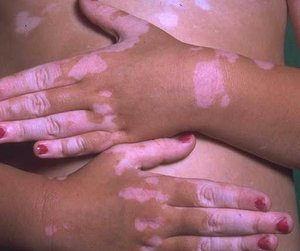When it comes to darker skin tones, there has been a shortage of reliable information to tell us which products and procedures are best suited to our needs. Until now. Dermatologists Jeanine Downie, M.D., and Fran Cook-Bolden, M.D., with Emmy Award-winning reporter Barbara Nevins Taylor, have filled the void with their new book, Beautiful Skin of Color: A Comprehensive Guide to Asian, Olive, and Dark Skin (Regan Books). Written as an A-to-Z manual, it covers topics from acne and eczema to sun protection and vitiligo. The book also features letters from everyday women with their questions about skin care, as well as straightforward explanations, advice and product recommendations to help you attain healthy, beautiful skin. Here we take a sneak peek at what the good doctors have to say about skin discoloration.
Joint Darkness
'I have a light-brown complexion, but my knees and elbows are black," Tanika writes. "It's been like this since I was little. I never wear skirts and always wear long sleeves. Is there anything I can do?"
It's not unusual for people to have severe discoloration that they want to cover up. Skin of color, ranging from the palest Asian tone to olive and the darkest of dark skin, is prone to darkening in certain areas. But people are often too embarrassed to talk about it. Over-the-counter creams and lotions aren't likely to work if the problem is severe or genetic. But in many cases there are remedies.
Why It Happens
Some people are born with darker skin on their joints. If this is a genetic problem, it may be impossible to make a significant difference. But the darkness may be caused by friction and the way your skin has responded to it. You started banging your elbows and knees when you were very young. We're all born with extra skin at the joints so that we can bend and stretch. If you have skin of color, that extra skin darkens easily.
Melanocytes, the cells that give our skin color, are very active in Asian, olive and dark skin. The slightest bump, bruise, scrape or trauma of any kind activates the melanocytes. In the joint areas the extra color cells get trapped in the extra skin. So if you're doing housework or anything that involves repeated pressure on your knees and elbows for long periods of time, it's likely that the skin over those joints will darken. Similarly if you're doing work or playing a game or sport that's rough on the hands, your knuckles will likely be darker than the rest of your skin. The same is true for your toes. If you squeeze your feet into great-looking shoes that hurt and scrunch the toes, your toe joints are likely to darken.
Doctor's Guidance
A dermatologist will use a combination of therapies to even the skin tone. Hydroquinone, which blocks the enzyme that produces color in the melanocytes, is most effective when combined with retinoids like Retin-A Micro. This full strength retinoid evens skin tone as it speeds the shedding of dead-skin cells. It also stimulates natural collagen production and gives the skin good texture.
Some prescription medications, such as EpiQuin Micro, Glyquin XM and Alustra, contain all these ingredients and others, including vitamins C and E--antioxidants that fight the oxygen compounds known as free radicals, which cause aging.
If the skin is very thick and very dark, the doctor may prescribe Tri-Luma Cream, a medication combining a hydroquinone, a retinoid and a steroid. Use the cream for a limited time only, and be sure its use is monitored carefully by a doctor.
Remedies
* In all situations, treat your skin gently. Think about your habits and the way your body moves and works. If you can eliminate some of the damaging action, you'll stop creating new dark-skin cells, which will be a step forward.
* Sunblock may not sound like an obvious solution, but it's important. Once the skin gets dark in an area, the sun will make it darker. We recommend a sunblock with UVA and UVB, Parsol 1789, and a sun-protection factor of at least 20. Apply the sunblock on every area exposed to the sun, paying particular attention to the joints.
* Lubricate dry areas. Because there's likely to be rough skin in these areas, it is a good idea to try to thin the skin a little bit with moisturizers containing lactic acid, such as AmLactin, LactiCare and Lac-Hydrin. They're available over the counter in most drugstores. Jergens Ash Relief, containing beta hydroxy acid, is an excellent moisturizer; Eucerin Alpha Hydroxy Moisturizer is also potent.
As you are thinning the skin, you also want to begin to try to slough off the dead dark-skin cells and fade what's left behind. That's where the vitamin A, or retinoid, products and other alpha and beta hydroxy acids come in. Over-the-counter products are a good way to begin to lighten skin color at the joints.
COPYRIGHT 2004 Essence Communications, Inc.
COPYRIGHT 2004 Gale Group




